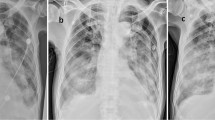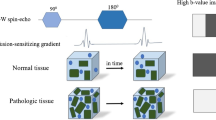Abstract.
Diffusion-weighted imaging (DWI) has been shown to be highly sensitive in detecting acute cerebral infarction, but its use in detecting hypoxic–ischemic encephalopathy (HIE) in neonates is still controversial. Moreover, few reports concern pre-term infants with possible periventricular leukomalacia (PVL). We examined the ability of this technique to detect cerebral changes in the acute phase of PVL. Fifteen MR examinations were performed in 11 pre-term infants (mean age 3.4 days, range 2–6 days). Conventional DWI sequences, apparent diffusion coefficient (ADC) maps, and US obtained in the acute phase were compared. All the neonates underwent US follow-up up to 4 months after delivery; those with suspected PVL also underwent MRI follow-up for up to 2 months. Qualitative and quantitative evaluations were performed to assess the presence of DW changes compatible with PVL. Diffusion-weighted MRI showed signal hyperintensity associated with decreased ADC values in 3 subjects (27%). In these patients conventional MRI sequences were interpreted as normal and US (performed at the same time) as doubtful in 2 and compatible with PVL in 1 subject. The MRI and US follow-up confirmed severe damage in all these patients. In 1 neonate hemorrhages involving the germinative matrix were identified. In 8 neonates MRI was considered normal. In these subjects US follow-up (up to 4 months) confirmed no signs of PVL. Diffusion-weighted imaging may have a higher correlation with later evidence of PVL than does conventional MR imaging and US when performed in the acute phase of the disease.



Similar content being viewed by others
References
van Everdingen KJ, van der Grond J, Kappelle LJ, Ramos LM, Mali WP (1998) Diffusion-weighted magnetic resonance imaging in acute stroke. Stroke 29:1783–1790
Moseley ME, Kucharczyk J, Mintorovitch J et al. (1990) Diffusion-weighted MR imaging of acute stroke: correlation with T2-weighted and magnetic susceptibility-enhanced MR imaging in cats. Am J Neuroradiol 11:423–429
Baird AE, Benfield A, Schlaug G et al. (1997) Enlargement of human cerebral ischemic lesion volumes measured by diffusion-weighted magnetic resonance imaging. Ann Neurol 41:581–589
Warach S, Chien D, Li W, Ronthal M, Edelman RR (1992) Fast magnetic resonance diffusion-weighted imaging of acute human stroke. Neurology 42:1717–1723
Warach S, Gaa J, Siewert B, Wielopolski P, Edelman RR (1995) Acute human stroke studied by whole brain echo planar diffusion-weighted magnetic resonance imaging. Ann Neurol 37:231–241
Burdette JH, Ricci PE, Petitti N, Elster AD (1998) Cerebral infarction: time course of signal intensity changes on diffusion-weighted MR images. Am J Roentgenol 171:791–795
Lovblad KO, Laubach HJ, Baird AE et al. (1998) Clinical experience with diffusion-weighted MR in patients with acute stroke. Am J Neuroradiol 19:1061–1066
Grunwald I, Reith W (2002) Non-traumatic neurological emergencies: imaging of cerebral ischemia. Eur Radiol 7:1632–1647
Cowan FM, Pennock JM, Hanrahan JD, Manji KP, Edwards AD (1994) Early detection of cerebral infarction and hypoxic ischemic encephalopathy in neonates using diffusion-weighted magnetic resonance imaging. Neuropediatrics 25:172–175
Robertson RL, Ben-Sira L, Barnes PD et al. (1999) MR line-scan diffusion-weighted imaging of term neonates with perinatal brain ischemia. Am J Neuroradiol 20:1658–1670
Johnson AJ, Lee BC, Lin W (1999) Echoplanar diffusion-weighted imaging in neonates and infants with suspected hypoxic-ischemic injury: correlation with patient outcome. Am J Roentgenol 172:219–226
Azzarelli B, Caldemeyer KS, Phillips JP, DeMyer WE (1996) Hypoxic–ischemic encephalopathy in areas of primary myelination: a neuroimaging and PET study. Pediatr Neurol 14:108–116
Tuor UI, Kozlowski P, Del Bigio MR et al. (1998) Diffusion- and T2-weighted increases in magnetic resonance images of immature brain during hypoxia–ischemia: transient reversal posthypoxia. Exp Neurol 150:321–328
Maalouf EF, Duggan PJ, Counsell SJ, Rutherford MA, Cowan F, Azzopardi D, Edwards AD (2001) Comparison of findings on cranial ultrasound and magnetic resonance imaging in preterm infants. Pediatrics 107:719–727
Volpe JJ (1991) Brain injury in the premature infant. Neuropathology, clinical aspects, pathogenesis, and prevention. Clin Perinatol 24:567–587
Inder T, Huppi PS, Zientara GP, Maier SE, Jolesz FA, Salvo D di, Robertson R, Barnes PD, Volpe JJ (1999) Early detection of periventricular leukomalacia by diffusion-weighted magnetic resonance imaging techniques. J Pediatr 134:631–634
Gelal FM, Grant PE, Fischbein NJ, Henry RG, Vigneron DB, Barkovich AJ (2001) The role of isotropic diffusion MRI in children under 2 years of age. Eur Radiol 11:1006–1114
Hill A (1997) Current concepts of hypoxic–ischemic cerebral injury in the term newborn. Pediatr Neurol 7:317–325
Forbes KPN, Pipe JG, Bird R (2000) Neonatal hypoxic–ischemic encephalopathy: detection with diffusion-weighted MR imaging. Am J Neuroradiol 21:1490–1496
Wolf RL, Zimmerman RA, Clancy R, Haselgrove JH (2001) Quantitative apparent diffusion coefficient measurements in term neonates for early detection of hypoxic–ischemic brain injury: initial experience. Radiology 218:825–833
Huppi PS, Murphy B, Maier SE, Zientara GP, Inder TE, Barnes PD, Kikinis R, Jolesz FA, Volpe JJ (2001) Microstructural brain development after perinatal cerebral white matter injury assessed by diffusion tensor magnetic resonance imaging. Pediatrics 107:
Roelants-van Rijn AM, Nikkels PG, Groenendaal F, van Der Grond J, Barth PG, Snoeck I, Beek FJ, de Vries LS (2001) Neonatal diffusion-weighted MR imaging: relation with histopathology or follow-up MR examination Neuropediatrics. 32:286–294
Carson SC, Hertzberg BS, Bowie JD, Burger PC (1990) Value of sonography in the diagnosis of intracranial hemorrhage and periventricular leukomalacia: a post-mortem study of 35 cases. Am J Neuroradiol 11:677–683
Maalouf EF, Duggan PJ, Counsell SJ, Rutherford MA, Cowan F, Azzopardi D, Edwards AD (2001) Comparison of findings on cranial ultrasound and magnetic resonance imaging in preterm infants. Pediatrics 107:719–727
Volpe JJ (2000) Neurology of the newborn, 4th edn. Saunders, Philadelphia
Rorke LB (1992) Anatomical features of the developing brain implicated in pathogenesis of hypoxic–ischemic injury. Brain Pathol 2:211–221
Inder TE, Volpe JJ (2000) Mechanisms of perinatal brain injury. Semin Neonatol 5:3–16
Chuang NA, Barkovich AJ, Henry RG, Miller SP, Vigneron DB (2001) Diffusion-weighted imaging for evaluation of brain injury in asphyxiated term neonates. Presentation number 33. Proc ASNR, Boston
Rumpel H, Nedelcu J, Aguzzi A, Martin E (1997) Late glial swelling after acute cerebral hypoxia–ischemia in the neonatal rat: a combined magnetic resonance and histochemical study. Pediatr Res 42:54–59
Myers RE (1975) Four patterns of perinatal brain damage and their conditions of occurrence in primates. Adv Neurol 10:223–234
Barkovich AJ (1992) MR and CT evaluation of profound neonatal and infantile asphyxia. Am J Neuroradiol 13:959–972
Barkovich AJ, Westmark KD, Bedi HS, Partridge JC, Ferriero DM, Vigneron DB (2001) Proton spectroscopy and diffusion imaging on the first day of life after perinatal asphyxia: preliminary report. Am J Neuroradiol 22:1786–1794
Author information
Authors and Affiliations
Corresponding author
Rights and permissions
About this article
Cite this article
Bozzao, A., Di Paolo, A., Mazzoleni, C. et al. Diffusion-weighted MR imaging in the early diagnosis of periventricular leukomalacia. Eur Radiol 13, 1571–1576 (2003). https://doi.org/10.1007/s00330-002-1815-2
Received:
Revised:
Accepted:
Published:
Issue Date:
DOI: https://doi.org/10.1007/s00330-002-1815-2




